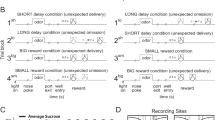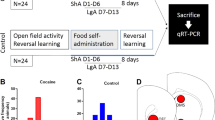Abstract
Rationale
Nicotine can enhance attention and attribution of incentive salience to nicotine-associated stimuli. However, it is not clear whether inter-individual differences in attentional capacities prior to any exposure could play a role in vulnerability to nicotine self-administration. We further explored this vulnerability through pre-existing inter-individual differences in attention to a reward-predictive cue in drug-free animals.
Methods
A cued version of the Fixed Consecutive Number schedule (FCN16cue) of reinforcement task was used to assess attention. This task consists in completing a long chain of sequential lever presses to obtain a reward, and examines the rats’ ability to pay attention to a cue light that signals its availability. Rats were then trained to self-administer nicotine intravenously (30 μg/kg/0.1 mL). Drug-taking and seeking behaviors were investigated.
Results
Our results showed important inter-individual differences in response for nicotine during the progressive ratio schedule of reinforcement. By comparing rats in the lower and upper quartiles of the mean breaking point, we showed that high-motivated rats were also more sensitive to the reinforcing properties of nicotine than low-motivated ones. We found that while both groups did not differ in premature responding in the FCN16cue task, high-motivated rats were more efficient in taking the cue light into account than low-motivated rats as shown by a higher proportion of optimal chains, indicating a higher level of attention to the reward-predictive cue. Moreover, it was positively correlated with higher motivation for nicotine, a hallmark of nicotine addiction.
Conclusions
These results suggest that higher attention to reward-associated cues prior to drug taking predicts vulnerability to nicotine-reinforcing properties.





Similar content being viewed by others

References
Anthony JC, Helzer JE (1995) Epidemiology of drug dependence. Comparative epidemiology of dependence on tobacco, alcohol, controlled substances, and inhalants: basic findings from the National Comorbidity Survey. Textbook of psychiatric epidemiology. Wiley. New York
Bizarro L, Stolerman IP (2003) Attentional effects of nicotine and amphetamine in rats at different levels of motivation. Psychopharmacology 170(3):271–277
Bueno-Junior LS, Simon NW, Wegener MA, Moghaddam B (2017) Repeated nicotine strengthens gamma oscillations in the prefrontal cortex and improves visual attention. Neuropsychopharmacology 42(8):1590–1598
Caggiula AR, Donny EC, White AR, Chaudhri N, Booth S, Gharib MA, Hoffman A, Perkins KA, Sved AF (2001) Cue dependency of nicotine self-administration and smoking. Pharmacol Biochem Behav 70(4):515–530
Caggiula AR, Donny EC, Palmatier MI, Liu X, Chaudhri N, Sved AF (2009) The role of nicotine in smoking: a dual-reinforcement model. Neb Symp Motiv 55:91–109
Caille S, Clemens K, Stinus L, Cador M (2012) Modeling nicotine addiction in rats. Methods Mol Biol 829:243–256
Chaudhri N, Caggiula AR, Donny EC, Booth S, Gharib M, Craven L, Palmatier MI, Liu X, Sved AF (2006a) Operant responding for conditioned and unconditioned reinforcers in rats is differentially enhanced by the primary reinforcing and reinforcement-enhancing effects of nicotine. Psychopharmacology 189(1):27–36
Chaudhri N, Caggiula AR, Donny EC, Palmatier MI, Liu X, Sved AF (2006b) Complex interactions between nicotine and nonpharmacological stimuli reveal multiple roles for nicotine in reinforcement. Psychopharmacology 184(3–4):353–366
Chiamulera C (2005) Cue reactivity in nicotine and tobacco dependence: a “multiple-action” model of nicotine as a primary reinforcement and as an enhancer of the effects of smoking-associated stimuli. Brain Res Brain Res Rev 48(1):74–97
Clemens KJ, Caillé S, Stinus L, Cador M (2009) The addition of five minor tobacco alkaloids increases nicotine-induced hyperactivity, sensitization and intravenous self-administration in rats. Int J Neuropsychopharmacol 12(10):1355–1366
Cohen C, Perrault G, Griebel G, Soubrie P (2005) Nicotine-associated cues maintain nicotine-seeking behavior in rats several weeks after nicotine withdrawal: reversal by the cannabinoid (CB1) receptor antagonist, rimonabant (SR141716). Neuropsychopharmacology 30(1):145–155
Dalley JW, Fryer TD, Brichard L, Robinson ES, Theobald DE, Laane K, Pena Y, Murphy ER, Shah Y, Probst K, Abakumova I, Aigbirhio FI, Richards HK, Hong Y, Baron JC, Everitt BJ, Robbins TW (2007) Nucleus accumbens D2/3 receptors predict trait impulsivity and cocaine reinforcement. Science 315(5816):1267–1270
Deroche-Gamonet V, Belin D, Piazza PV (2004) Evidence for addiction-like behavior in the rat. Science 305(5686):1014–1017
Diergaarde L, Pattij T, Poortvliet I, Hogenboom F, de Vries W, Schoffelmeer AN, De Vries TJ (2008) Impulsive choice and impulsive action predict vulnerability to distinct stages of nicotine seeking in rats. Biol Psychiatry 63(3):301–308
Donny EC, Chaudhri N, Caggiula AR, Evans-Martin FF, Booth S, Gharib MA, Clements LA, Sved AF (2003) Operant responding for a visual reinforcer in rats is enhanced by noncontingent nicotine: implications for nicotine self-administration and reinforcement. Psychopharmacology 169(1):68–76
Economidou D, Pelloux Y, Robbins TW, Dalley JW, Everitt BJ (2009) High impulsivity predicts relapse to cocaine-seeking after punishment-induced abstinence. Biol Psychiatry 65(10):851–856
Evenden JL (1998) The pharmacology of impulsive behaviour in rats II: the effects of amphetamine, haloperidol, imipramine, chlordiazepoxide and other drugs on fixed consecutive number schedules (FCN 8 and FCN 32). Psychopharmacology 138(3–4):283–294
Falco AM, Bevins RA (2015) Individual differences in the behavioral effects of nicotine: a review of the preclinical animal literature. Pharmacol Biochem Behav 138:80–90
Garcia-Rivas V, Cannella N, Deroche-Gamonet V (2017) Individual variations in the mechanisms of nicotine seeking: a key for research on nicotine dependence. Neuropsychopharmacology 42(3):584–586
Janes AC, Pizzagalli DA, Richardt S, de BFB, Chuzi S, Pachas G, Culhane MA, Holmes AJ, Fava M, Evins AE, Kaufman MJ (2010) Brain reactivity to smoking cues prior to smoking cessation predicts ability to maintain tobacco abstinence. Biol Psychiatry 67(8):722–729
Levin ED, McClernon FJ, Rezvani AH (2006) Nicotinic effects on cognitive function: behavioral characterization, pharmacological specification, and anatomic localization. Psychopharmacology 184(3–4):523–539
Mogg K, Bradley BP (2002) Selective processing of smoking-related cues in smokers: manipulation of deprivation level and comparison of three measures of processing bias. J Psychopharmacol 16(4):385–392
Mogg K, Bradley BP, Field M, De Houwer J (2003) Eye movements to smoking-related pictures in smokers: relationship between attentional biases and implicit and explicit measures of stimulus valence. Addiction 98(6):825–836
Molander AC, Mar A, Norbury A, Steventon S, Moreno M, Caprioli D, Theobald DE, Belin D, Everitt BJ, Robbins TW, Dalley JW (2011) High impulsivity predicting vulnerability to cocaine addiction in rats: some relationship with novelty preference but not novelty reactivity, anxiety or stress. Psychopharmacology 215(4):721–731
Palmatier MI, Marks KR, Jones SA, Freeman KS, Wissman KM, Sheppard AB (2013) The effect of nicotine on sign-tracking and goal-tracking in a Pavlovian conditioned approach paradigm in rats. Psychopharmacology 226(2):247–259
Paolone G, Angelakos CC, Meyer PJ, Robinson TE, Sarter M (2013) Cholinergic control over attention in rats prone to attribute incentive salience to reward cues. J Neurosci 33(19):8321–8335
Perkins KA, Karelitz JL, Boldry MC (2017) Nicotine acutely enhances reinforcement from non-drug rewards in humans. Front Psychiatry 8:65
Reisiger AR, Kaufling J, Manzoni O, Cador M, Georges F, Caille S (2014) Nicotine self-administration induces CB1-dependent LTP in the bed nucleus of the stria terminalis. J Neurosci 34(12):4285–4292
Richardson NR, Roberts DC (1996) Progressive ratio schedules in drug self-administration studies in rats: a method to evaluate reinforcing efficacy. J Neurosci Methods 66(1):1–11
Rivalan M, Gregoire S, Dellu-Hagedorn F (2007) Reduction of impulsivity with amphetamine in an appetitive fixed consecutive number schedule with cue for optimal performance in rats. Psychopharmacology 192(2):171–182
Rivalan M, Valton V, Series P, Marchand AR, Dellu-Hagedorn F (2013) Elucidating poor decision-making in a rat gambling task. PLoS One 8(12):e82052
Robinson TE, Flagel SB (2009) Dissociating the predictive and incentive motivational properties of reward-related cues through the study of individual differences. Biol Psychiatry 65(10):869–873
Semenova S, Stolerman IP, Markou A (2007) Chronic nicotine administration improves attention while nicotine withdrawal induces performance deficits in the 5-choice serial reaction time task in rats. Pharmacol Biochem Behav 87(3):360–368
Sorge RE, Pierre VJ, Clarke PB (2009) Facilitation of intravenous nicotine self-administration in rats by a motivationally neutral sensory stimulus. Psychopharmacology 207(2):191–200
Versaggi CL, King CP, Meyer PJ (2016) The tendency to sign-track predicts cue-induced reinstatement during nicotine self-administration, and is enhanced by nicotine but not ethanol. Psychopharmacology 233(15–16):2985–2997
Waters AJ, Shiffman S, Sayette MA, Paty JA, Gwaltney CJ, Balabanis MH (2003) Attentional bias predicts outcome in smoking cessation. Health Psychol 22(4):378–387
WHO (2015) WHO global report on trends in prevalence of tobacco smoking. Ed organization WH
Yager LM, Robinson TE (2015) Individual variation in the motivational properties of a nicotine cue: sign-trackers vs. goal-trackers. Psychopharmacology 232(17):3149–3160
Acknowledgements
The authors would like to thanks Haley Province for the editorial support. This work was supported by the Centre National de la Recherche Scientifique, University of Bordeaux, and Region Aquitaine.
Author information
Authors and Affiliations
Contributions
SC, MC, and FDH developed the concept and design of the study. YV and EN performed the experiments. YV, SC, and FDH participated in data analysis and interpretation of the findings. YV, FDH, and SC wrote the paper. All authors critically reviewed content and approved the final version for publication.
Corresponding authors
Ethics declarations
Conflict of interest
The authors declare that they have no conflict of interest.
Rights and permissions
About this article
Cite this article
Vandaele, Y., Noe, E., Cador, M. et al. Attentional capacities prior to drug exposure predict motivation to self-administer nicotine. Psychopharmacology 235, 2041–2050 (2018). https://doi.org/10.1007/s00213-018-4901-0
Received:
Accepted:
Published:
Issue Date:
DOI: https://doi.org/10.1007/s00213-018-4901-0



